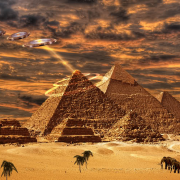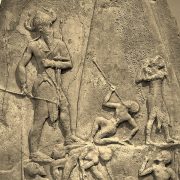The account of chaos—Leviathan—in Psalm 74 is a bit different from that in Genesis 1. We learn God is from old, working salvation in the midst of the earth (which again, at the beginning would have been only water). Then we learn God divides the seas (which, in Genesis, occurs in Genesis 1:6) and breaks the heads of the sea monsters, along with crushing the heads of Leviathan. Later, we learn God establishes the heavenly lights and the sun (which, in Genesis, doesn’t occur until the fourth day, described in Genesis 1:14–19).
It is generally believed among biblical scholars Psalm 74 and Genesis 1 are likely polemics of the Baal Cycle. That is to say, they are attempts to take credit away from Baal for subduing chaos (Leviathan) and giving proper credit to YHWH for this and for creation itself. It is known from tablets found in Syria over the last 150 years that the Semites of western Mesopotamia, the Amorites and Canaanites, believed that it was their storm-god Baal who had subdued the chaos monster.
Thus says Adad, I brought you back to the throne of your father, I brought you back. The weapons with which I fought Tiamat I gave to you. With the oil of my bitter victory I anointed you, and no one before you could stand.[1]
Adad is the actual name of the west Semitic storm-god we know in the Bible as Baal. (“Baal” is a title that means “lord,” not a proper name.) The excerpt above is from a letter from Adad through his prophet, Abiya, to the king of Mari, Zimrī-Līm. The god was apparently reminding Zimrī-Līm that the king had been restored to power by his divine favor, which included sending to Zimrī-Līm the clubs he’d used to defeat Tiamat!
Another tablet found at Mari, which was located on the Euphrates River near the modern border between Syria and Iraq, confirms that the clubs had been sent from Aleppo, which was known as the “city of Adad,” to the temple of Dagan (the earlier spelling of the Philistine god Dagon) at the town of Terqa, south of Mari.
While that’s a fascinating bit of history—think about that: the divine clubs of Baal were physical objects!—the point is that Zimrī-Līm ruled at the same time as Hammurabi the Great of Babylon, which is about the time scholars believe the Enuma Elish was composed, and at least four hundred years before the Baal Cycle. So, it appears that even between Baal and Marduk there was competition over just who defeated the monstrous god of chaos.
We must remember, people in the ancient Near East would not have the type of scientific, literal, and material point of view we have today in the western world. Rather, their view would have been more symbolic. This doesn’t mean it is any less real or true, it is merely a different way of looking at the world. When we look at the sea, we think of ocean currents and marine biology. When they looked at it, they thought of Leviathan/Tiamat/Litanu, chaos, and death. Therefore, what we have in Genesis 1 and Psalm 74 is not a scientific description of how everything was created, but a symbolic polemic describing who gets the credit for creating everything. According to the Bible, it’s not Baal. It’s not Marduk. It is YHWH.
One might wonder, if it is a polemic, where is the battle? It is true, we do not see an epic battle in Genesis 1. There is a description of a defeat in Psalm 74, but it is still quite different when compared against the Baal Cycle. The idea conveyed by the biblical writers is when YHWH of Israel started creation, these chaotic forces were already held in check. There was no need for a battle; Leviathan was already bound because the one true God didn’t need to fight.
This would have been considered a slap in the face to Canaanite religion and the inferior god Baal. It was saying YHWH is the God who is truly in control and always has been. YHWH restricts chaos, not Baal. If a Canaanite living at that time were to read the Genesis account of creation, he would understand instantly what the text was doing. It’s busting down Baal and lifting up YHWH as supreme.
We see this same sort of thing in Psalm 89:
You rule the raging of the sea; when its waves rise, you still them. You crushed Rahab like a carcass; you scattered your enemies with your mighty arm. The heavens are yours; the earth also is yours; the world and all that is in it, you have founded them. (Psalm 89:9–11, ESV)
This idea is repeated as an apocalyptic idea by the prophet Isaiah 27:
In that day the LORD with his hard and great and strong sword will punish Leviathan the fleeing serpent, Leviathan the twisting serpent, and he will slay the dragon that is in the sea. (Isaiah 27:1, ESV)
In Psalm 89, Rahab is a name for Egypt but is also equated with the sea beast Leviathan. In Isaiah 27, we read of a time in the future where chaos is not simply subdued but is destroyed forever. Consider what John N. Oswalt’s commentary on the book of Isaiah says about this:
Most scholars today are in agreement that while the exodus events are in the center of the writer’s thinking, they are not by any means all that is there. Rahab is clearly a term for Egypt (cf. 30:7; and Ps. 87:4, where Rahab and Babylon are paired); so also the monster (or “dragon”) is a term for Pharaoh (Ezek. 29:3). But it is also clear that those terms are not limited to those historical referents. As is known from Ugaritic studies, the twisting monster is a figure in the struggles of Baal with the god of the sea, Yam, as is “Leviathan,” which is equated with the monster in Isa. 27:1. Given these facts, and the evidence that the myth of the struggle of the gods with the sea monster was known in one form or another all over the ancient Near East, one has reason to believe that Isaiah is here, as in 27:1, utilizing this acquaintance among the people for his own purposes. It is important to note that the allusions to Near Eastern myths in the Bible all occur after 750 B.C., long after the basic antimythic character of biblical faith had been established. Thus there is an appeal here neither to some current Hebrew myth nor to some original one, now dead. Rather, just as a contemporary poet might allude to the Iliad or the Odyssey, utilizing imagery familiar to his hearers but that is hardly part of their belief system, so Isaiah uses the imagery of the well-known stories of creation to make his point. It was not Baal or Marduk or Ashur who had any claim to being the Creator—it was the Lord alone.[2]
The idea coming out of this comparison of Psalm 74 and Genesis 1 is that by the time the actual creation starts, Leviathan/Chaos is already subdued. This would seem to indicate in the text, at least in the mind of the writers of these passages, there is a lot more going on with Genesis 1:1-3 than what we are typically taught in Sunday school. We learn in the very first verse God created the heavens and the earth. However, what was that process like? What were the conditions? How long did it take? We are not told specifically, but we are given clues if we think of this as a polemic on ancient Canaanite religion.
Whether taken as literal or symbolic, the texts indicate a creation story unlike anything most of us were taught in the Church, but it’s one that biblical scholars are very familiar with. The sea represents chaos, yet as we see in Genesis 1:2, chaos is already subdued by the Spirit of God hovering over the face of the waters. The battle was over before it began. Whether Leviathan is meant to be understood as a literal sea beast existing somewhere in spiritual existence or as a symbol for the very real chaos of nature is unknown. Perhaps it is both. In any event, the text allows us a little more freedom in understanding creation than what we may have previously been taught.
There are other interesting things to pull from this idea as well. In Genesis, once the water was still and chaos subdued, God started to create order from disorder. This idea, order from disorder, is common throughout ancient near-eastern religious texts, yet the writer of Genesis gives proper credit to YHWH, the God of Israel. To the writer of Genesis, the other, lesser gods tried to usurp YHWH’s accomplishments and attributes, so he wishes to set the record straight.
The main reason for reiterating this point is because there are occult/pagan circles today who follow doctrines related to “order out of chaos,” “as above, so below,” and others. Since, in our culture today, those are recognized as doctrines outside of Christianity, it is worth repeating the point of polemics here. It seems the writer of Genesis was dealing with a similar thing in his day, so to set the record straight, he gave credit to YHWH for these things instead of allowing the lesser gods to usurp and defile them.
[1] “A Prophetic Letter of Adad to Zimrī-Līm” (A.1968). English translations in J. J. M. Roberts, The Bible and the Ancient Near East. Collected Essays (Winona Lake, IN: Eisenbrauns, 2002), ch. 14, pp. 157-253, “The Mari Prophetic Texts in Transliteration and English Translation,” and in M. Nissinen, Prophets and Prophecy in the Ancient Near East, with contributions by C. L. Seow and R. K. Ritner (ed. P. Machinist; Writings from the Ancient World, 12; Atlanta, GA., Society of Biblical Literature, 2003), pp. 21-22 (A. 1968).
[2] John N. Oswalt, The Book of Isaiah, Chapters 40–66, The New International Commentary on the Old Testament, Grand Rapids, MI: Wm. B. Eerdmans Publishing Co., 1998), 341-42.

Derek Gilbert Bio
Derek P. Gilbert hosts SkyWatchTV, a Christian television program that airs on several national networks, the long-running interview podcast A View from the Bunker, and co-hosts SciFriday, a weekly television program that analyzes science news with his wife, author Sharon K. Gilbert.
Before joining SkyWatchTV in 2015, his secular broadcasting career spanned more than 25 years with stops at radio stations in Philadelphia, Saint Louis, Little Rock, and suburban Chicago.
Derek is a Christian, a husband and a father. He’s been a regular speaker at Bible prophecy conferences in recent years. Derek’s most recent book is The Great Inception: Satan’s PSYOPs from Eden to Armageddon. He has also published the novels The God Conspiracy and Iron Dragons, and he’s a contributing author to the nonfiction anthologies God’s Ghostbusters, Blood on the Altar, I Predict: What 12 Global Experts Believe You Will See by 2025, and When Once We Were a Nation.









Leave a Reply
Want to join the discussion?Feel free to contribute!